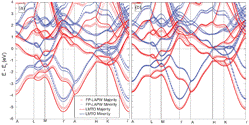Department of Physics and Astronomy: Publications and Other Research

Kirill Belashchenko Publications
Document Type
Article
Date of this Version
2012
Citation
PHYSICAL REVIEW B 86, 224402 (2012)
Abstract
Spin injection from a half-metallic electrode in the presence of thermal spin disorder is analyzed using a combination of random matrix theory, spin-diffusion theory, and explicit simulations for the tight-binding s-d model. It is shown that efficient spin injection from a half-metal is possible as long as the effective resistance of the normal metal does not exceed a characteristic value, which does not depend on the resistance of the half-metallic electrode but, rather, is controlled by spin-flip scattering at the interface. This condition can be formulated as α < l/ lN sf Tc -1, where α is the relative deviation of the magnetization from saturation, l and lN sf are the mean-free path and the spin-diffusion length in the nonmagnetic channel, and Tc is the transparency of the tunnel barrier at the interface (if present). The general conclusions are confirmed by tight-binding s-d model calculations. A rough estimate suggests that efficient spin injection from true half-metallic ferromagnets into silicon or copper may be possible at room temperature across a transparent interface.


Comments
©2012 American Physical Society